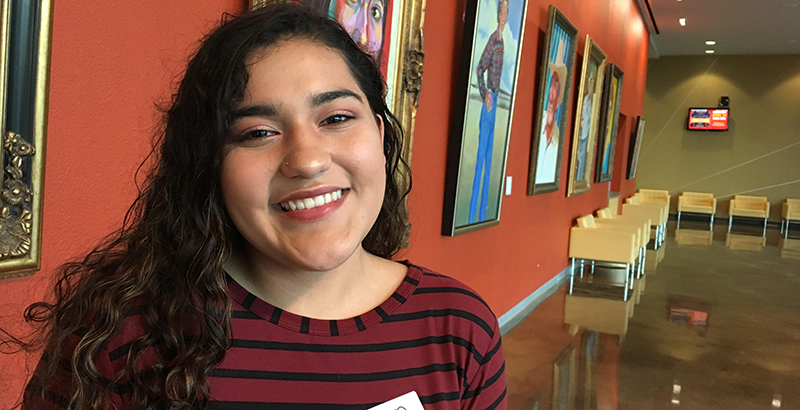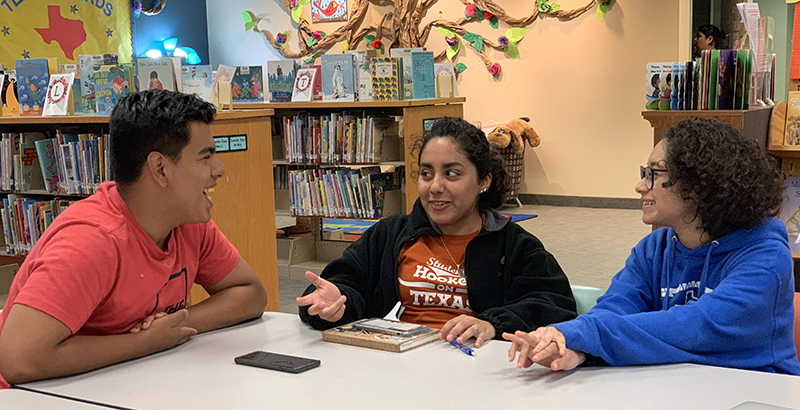‘Kids Are Being Arrested, but They Don’t Ask, “Are You OK?”’: San Antonio Students Advocate for Their Own Mental Health, but the Odds Are Against Them

Sixteen-year-old Madisyn Donovan was frequently in trouble. An early college high school student in the spring of 2018, actively involved in clubs and extracurriculars, she wasn’t acting out. She wasn’t disruptive, defiant or disrespectful. What Donovan was, was depressed — and her efforts to get treatment put her academic career in jeopardy.
Her school guidance counselor couldn’t help, other than to give her a list of three local clinical psychiatrists, all with waiting lists months long.
To get the assistance she needed, Donovan knew, she’d have to look at another part of town, one where hospitals and doctors are more common than the salvage yards and landfills surrounding her neighborhood in southwest San Antonio.
Sure enough, Donovan was able to see a north side psychiatrist within days. But getting there meant spending as much as two hours each way on a city bus. Her appointments were all during working hours, so her father couldn’t drive her, and she needed to leave school an hour early to get there on time.
That’s how she started racking up absences and truancy write-ups. Teachers warned her that if these unexcused absences continued, she would lose class credit under district policy. She had to choose between staying on track toward graduation and getting the mental health care she needed. In the end, Donovan chose to quit therapy and save her credits.
The high school sophomore was in a damned-if-you-do, damned-if-you-don’t situation. The abuse that triggered her depression, the physical distance between her house and her psychiatrist, and the way the district handled her efforts to get help were all what she termed “walls” standing between her and her mental health — “walls that, as a student, I shouldn’t be running into,” she said.
While depression made it difficult for her to concentrate — or even to show up at school — Donovan acknowledged that other students had it worse than she did. Kids who respond to stress with more fight than flight are more likely to get in trouble than they are to get help. In South San Antonio, psychiatrists are hard to find — but police officers are not. With cops stationed in many schools, disciplinary behaviors that were once the jurisdiction of school administrators are now in the hands of campus police.
“A lot of kids are being arrested,” Donovan said. “But they don’t ask, ‘Are you OK?’”
Like many districts, South San Antonio Independent School District — where nearly 98 percent of students are Hispanic and 72 percent are considered at-risk — beefed up its campus police force after the Sandy Hook school shooting in 2012. The district has 17 police officers for 9,000 students across nine campuses, nearly double the recommended number. But its 20 counselors and one licensed social worker are fewer than the American School Counselor Association recommends.
Students at South San have begun to advocate for more mental health resources in their schools, becoming increasingly vocal and politically active — speaking up at board meetings and town halls, questioning school board members in the press and on social media. But they feel rebuffed from all sides, caught in a turbulent confluence of community segregation and campus policing that mires potential solutions in a political undertow.
‘Some of the most stressed-out people I know’
Donovan said she has watched friends at South San Antonio High School fall into the notorious “school-to-prison pipeline” because they were too depressed or anxious to get to school and keep up with classes. Staying on course required more mental and emotional stamina than they had. Hopeless kids dropped out. Lonely kids turned to gangs. “They are some of the most stressed-out people I know,” she said. “They end up in gangs because they need support and hope to find it there.”
Ideally, students would turn to trusted adults or counselors for that support and hope. But in many places in America, that’s easier said than done.
In February, the Journal of the American Medical Association Pediatrics reported that the need for, and access to, mental health care for children ages 6 to 17 varies dramatically from state to state. The report ranked states on the number of diagnoses and on the percentage of children diagnosed who did and did not receive treatment. Maine had the highest prevalence of diagnosed depression, anxiety and ADHD, at 27 percent of the population. Around half of those kids received treatment. North Carolina had the highest prevalence of untreated mental health issues: Of the 15 percent to 17 percent diagnosed with depression, anxiety or ADHD, 72 percent got no help.
Mississippi, Alabama, Utah and Oklahoma had among the highest rates of diagnosed kids who go untreated. Iowa had among the lowest rates in the country for diagnosing depression, anxiety and ADHD but among the highest rates for treatment.
However, summary data of states and even counties or cities can be deceiving. Mental health deserts can be as small as a census tract, a zip code or even an understaffed health institution. For teens or people without transportation living in those areas, that’s still a desert — and they exist in every state.
Like many other industries — shipyards, entertainment, tourism, manufacturing — mental health providers tend to cluster. In San Antonio, medical services gravitate to the area around the South Texas Medical Center on the city’s more affluent north side. On the southwest side, the flat, shrubby land has typically been used for landfills. Community Information Now, a public data service, identifies 78 psychiatrists in the zip code that contains the hospital. In the South San area, there are three, as Donovan found out.
“We’re the side of town that has always been dumped on,” said former city councilman Rey Saldaña, who represented the area. “Literally.”
Psychiatrists do not set up shop around the landfill industry.
The counselors and social workers who try to fill that void cannot prescribe medications used to treat severe depression, anxiety or ADHD, as medical doctors can. Still, while they cannot address every condition, practitioners working on the south side see as many students as possible, and they say their calendars are full.
South San is short of the 1:250 counselor-to-student ratio recommended by the American School Counselor Association, and where they do exist in schools, counselors are often co-opted by administrators into performing administrative roles, like proctoring tests. The district’s 12 campuses share one behavioral therapist, who functions like a social worker.
Communities in Schools of San Antonio tries to fill in by providing licensed counselors and social workers to campuses through its mental health care initiative, Project Access. The organization has long been funded for college readiness support; clinical counseling was not part of its scope. But this year, the district paid to bring in two full-time Project Access counselors as an easily accessible point of contact for triage, acute emotional support and first steps toward treatment. Because they are not district employees, Communities in Schools staff cannot be assigned to other duties. However, they are often grant-funded, and at times the scope of their grant determines what help they can and cannot offer to students.
“We’re really designed to be short term,” said the organization’s executive director, Jessica Weaver. “There are students for whom the issues are bigger.”
‘Rich kids go to therapy, poor kids go to jail’
Donovan and her friends are acutely aware they are on the losing end of a resource shortage beyond the schoolhouse. Living in a high-poverty area is stressful in and of itself; the lack of available help makes it worse. When destructive behaviors brought on by mental illness go unchecked, and there are no doctors, licensed counselors or social workers to intervene, students find themselves answering to the police.
As Melivia Mujica, one of Donovan’s friends and fellow activists, put it, “Rich kids go to therapy, poor kids go to jail.”
Nationwide, districts have increased the number of police officers on campus and implemented hardening measures to prevent school shootings, including metal detectors, active shooter drills and security systems. The school safety industry has become a $3 billion business.
While intended to make students safer, campus policing also raises concerns. According to the American Civil Liberties Union, “black students are more than twice as likely as their white classmates to be referred to law enforcement or arrested at school.” At the same time, nearly a quarter of the jail population and around 14 percent of the prison population show signs of mental health disorders, including depression — much of it untreated.
Texas Democratic legislator James Talarico proposed a bill as part of his whole-student agenda mandating a 1:4 ratio of police to mental health professionals in schools. Districts with heavily staffed police forces protested, saying it would be prohibitively costly, and the bill didn’t advance.
Some have suggested that as an alternative to mental health providers, police could fill that role.
Illinois recently passed a law requiring school resource officers to be trained to work with children who suffer from trauma. Entire police forces, both municipal and district, have also begun to offer optional trauma training. Police learn the signs and symptoms of trauma, such as lashing out, refusing to acknowledge others or irrationally escalating conflict, that might otherwise be viewed as aggression, so they can approach students in a way that moves them out of fight-or-flight mode and into a more rational frame of mind.
Melissa Tijerina, vice president of child behavioral health at Bexar County’s Center for Health Care Services, said everyone who works with children should be trained in mental health first aid, just like CPR or the Heimlich maneuver.
The center operates five sites around the city, including some of the nearest adolescent psychiatric care available for South San students — eight miles away, 45 minutes on the bus. Wait times for services vary based on the level of crisis and the specific program a student needs. Medicaid waiver programs, juvenile justice programs and in-patient treatment all require more administration than a typical clinical visit.
“All of us in the industry do our level best to make sure that our services are available right away,” Tijerina said.
According to South San students, the same cannot be said of the school board.
Politics instead of problem-solving
Classmates Marc Mendiola, 18; Evony Gonzalez, 15; Mujica, 18; and Donovan are among 20 or so South San students who for the past two years have been actively advocating for more mental health resources. They attend board meetings, call their elected representatives and regularly do battle with school board members over social media.
Mujica and Gonzalez recently shared their stories before the board, explaining how depression plagued them no matter how successful or involved in school they were.
“I’m one of the lucky ones who overcame the darkness,“ Mujica told the board. “Finding help wasn’t easy.”
One session they attended, a board budget meeting, Mujica summed up as “six hours of nonsense and bickering.” The teenagers sat through the session, they explained, because they wanted to understand how money was being spent if not on mental health resources.
“Every time we came up with these suggestions, they would say, ‘We don’t have the money,’” Mendiola said.

The district has been in and out of oversight and sanction by the Texas Education Agency for 10 years due to financial mismanagement and board dysfunction. A strong board and superintendent had seemed to be making headway, trying to chip away at a $6.4 million budget shortfall brought on by declining enrollment. They decided to close three underenrolled schools, opening up what students saw as a golden opportunity.
Working with Saldaña, himself a South San alum, the students began advocating for a community mental health resource center, run by the city of San Antonio, at one of the shuttered campuses, Kazen Middle School.
Saldaña’s City Council office drew up plans for the facility and a $10 million bond package for startup costs. He had reached out ahead of board meetings in December, January and February to ask that the proposal be considered.
The board never got back to him, he said.
After the November 2018 election, the board swung back to control of longtime member Connie Prado, who had vocally and publicly opposed the closures, even going so far as to campaign against a school district tax increase — a move all but unheard of for a sitting board member — as long as the campuses remained shuttered.
In January, she rallied board support to reopen the three campuses by next year, despite advice from district administration that it would be fiscally irresponsible. The Texas Education Agency promptly began an investigation into the district.
Students began asking where the money to reopen the schools came from — and why it hadn’t been there for mental health services. Prado told The 74 the district could receive some new state funds for mental health resources this year and in the meantime is doing what it can to connect students to help. The board has asked the South San district administration to look into “three in-district facility locations where we could consolidate mental health resources,” she said.
At a March 26 meeting, students signed up as citizens to be heard and used their three minutes apiece to outline their own mental health struggles and ask the board to consider moving forward with the Kazen mental health center.
The board did eventually make a counteroffer with a different property, adjacent to Kazen, but in the five months of silence, Saldaña said, the city opened up the offer to other south side institutions — a community college and Texas A&M University–San Antonio — that were willing to put up stronger facilities and operations funding. If the community does want the resource center on district property, South San will now have to compete for what was originally an exclusive offer.
The 32-year-old politician felt compelled to get involved after watching the fate of his own South San classmates. He regularly talks about visiting old friends in jail, but after they returned to the community, he discovered that the mental health issues that had gotten them into trouble hadn’t gone away. “There’s a pipeline even after prison,” he explained. This year, a friend who was released after serving a three-year jail term committed suicide. “He just didn’t know how to ask for help,” Saldaña said.
The stigma around mental health on the south Side is decreasing, but it’s far from gone, he admitted. Somehow the South San students figured out that help was out there, but if they get the message that voicing their own mental health concerns will cause people to distrust them because they admit they have a problem, he said, he wonders if it would set the community back. More people need to see their neighbors getting help, getting healthy and flourishing because of it.
“We don’t know how to open the door,” he said. “We don’t know what it’s supposed to feel like.”
On the South Side of San Antonio, there aren’t a lot of doors to open in the search for help.
‘Parentified’ children
One door that is open belongs to the Southside Counseling Group, which leases space to five counselors specializing in adolescent mental health. Four of them speak Spanish. Ninety percent of their clients pay through Medicaid. The group is located across the street from South San High School and frequently takes referrals, said administrator Gayle Arambula. While the clinic can usually see crisis patients immediately, most therapists are completely booked, Arambula said: “We’re bursting at the seams here!”
Over the years, she and her husband, Joe Arambula, the group’s lead counselor, have seen practitioners come and go. They’ve also had a very difficult time finding psychiatrists when clients need prescriptions or other medical-oriented mental health care. “We’re not exactly sure why,” Gayle Arambula said. “You have to find somebody dedicated to this population.”
Although bullying, substance abuse and sexual abuse seem to affect children in every part of town, Joe Arambula explained, poverty does not. “When you’re dealing with kids, you have to really know the population,” he said.
Students who grow up in poverty are often what he called parentified, meaning they take on parental roles with siblings and even elderly relatives, but without adult-level support or skills. They are often the financial and emotional leaders in their household, and they are afraid to admit their depression and anxiety, or speak up about abuse, because they feel responsible for maintaining stability, he said. “These kids keep it to themselves for years because they are worried about the repercussions.”
The Southside Counseling Group has been burned once or twice by practitioners who signed on but weren’t committed to taking on the systemic challenges of poverty. “When people come here,” Gayle Arambula said, “we have to make sure that they are very, very culturally competent.”
South San’s single case worker described listening to the challenges confronting the district’s students.
“These issues [students face] were traumatic [to hear] as an adult,” said Susan Arciniega, according to The Rivard Report. “I can’t even imagine … how difficult it must have been. I know we had a student who had to witness the [murder] of his parents and his family. No one should ever have to do that.
“I need more help. I need more staff. We’re not here 365 days, and that concerns me. … We are not at a preventative stage. We are at an intervention, crisis stage.”
Get stories like these delivered straight to your inbox. Sign up for The 74 Newsletter

;)
